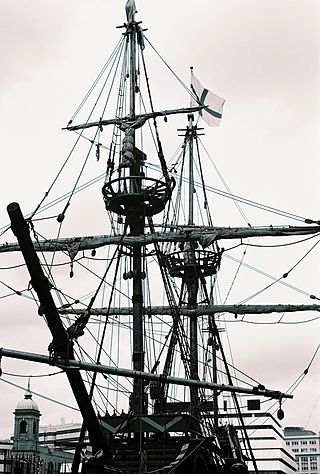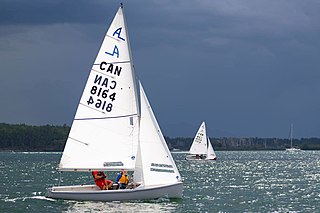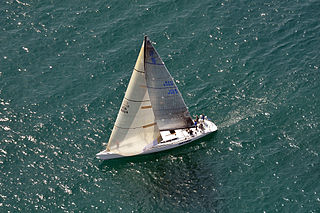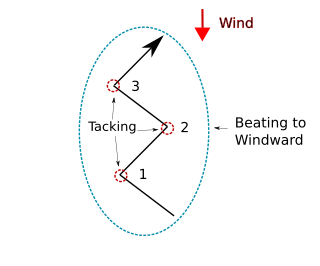
Rigging comprises the system of ropes, cables and chains, which support a sailing ship or sail boat's masts—standing rigging, including shrouds and stays—and which adjust the position of the vessel's sails and spars to which they are attached—the running rigging, including halyards, braces, sheets and vangs.

A sailboat or sailing boat is a boat propelled partly or entirely by sails and is smaller than a sailing ship. Distinctions in what constitutes a sailing boat and ship vary by region and maritime culture.

Sailing rigs describe the arrangement of sailing vessels' rig components, including their spars, rigging, and sails. Examples include a schooner rig, cutter rig, junk rig, etc. Rigs may be broadly categorized as fore-and-aft and square-rigged. They may incorporate a mixture of both categories. Within the fore-and-aft category there is a variety of triangular and quadrilateral sail shapes. Spars or battens may be used to help shape a given kind of sail. Each rig may be described with a sail plan—formally, a drawing of a vessel, viewed from the side.

A catboat is a sailboat with a single sail on a single mast set well forward in the bow of a very beamy and (usually) shallow draft hull. Typically they are gaff rigged, though Bermuda rig is also used. Most are fitted with a centreboard, although some have a keel. The hull can be 12 to 40 feet long with a beam half as wide as the hull length at the waterline. The type is mainly found on that part of the Eastern seaboard of the USA from New Jersey to Massachusetts.

Standing rigging comprises the fixed lines, wires, or rods, which support each mast or bowsprit on a sailing vessel and reinforce those spars against wind loads transferred from the sails. This term is used in contrast to running rigging, which represents the moveable elements of rigging which adjust the position and shape of the sails.

The Albacore is a 4.57 m (15 ft) two-person planing dinghy, for competitive racing and lake and near-inshore day sailing. Hulls are made of either wood or fiberglass. The basic shape was developed in 1954 from an Uffa Fox design, the Swordfish. Recent boats retain the same classic dimensions, and use modern materials and modern control systems.

A genoa sail is a type of large jib or staysail that extends past the mast and so overlaps the main sail when viewed from the side, sometimes eliminating it. It was originally called an "overlapping jib" and later a genoa jib. It is used on single-masted sloops and twin-masted boats such as yawls and ketches. Its larger surface area increases the speed of the craft in light to moderate winds; in high wind, a smaller jib is usually substituted, and downwind a spinnaker may be used.

Boat building is the design and construction of boats and their systems. This includes at a minimum a hull, with propulsion, mechanical, navigation, safety and other systems as a craft requires.

A spinnaker is a sail designed specifically for sailing off the wind on courses between a reach to downwind. Spinnakers are constructed of lightweight fabric, usually nylon, and are often brightly colored. They may be designed to perform best as either a reaching or a running spinnaker, by the shaping of the panels and seams. They are attached at only three points and said to be flown.

Running rigging is the rigging of a sailing vessel that is used for raising, lowering, shaping and controlling the sails on a sailing vessel—as opposed to the standing rigging, which supports the mast and bowsprit. Running rigging varies between vessels that are rigged fore and aft and those that are square-rigged.

The mast of a sailing vessel is a tall spar, or arrangement of spars, erected more or less vertically on the centre-line of a ship or boat. Its purposes include carrying sails, spars, and derricks, giving necessary height to a navigation light, look-out position, signal yard, control position, radio aerial or signal lamp. Large ships have several masts, with the size and configuration depending on the style of ship. Nearly all sailing masts are guyed.
This glossary of nautical terms is an alphabetical listing of terms and expressions connected with ships, shipping, seamanship and navigation on water. Some remain current, while many date from the 17th to 19th centuries. The word nautical derives from the Latin nauticus, from Greek nautikos, from nautēs: "sailor", from naus: "ship".

Tacking or coming about is a sailing maneuver by which a sailing craft, whose next destination is into the wind, turns its bow toward and through the wind so that the direction from which the wind blows changes from one side of the boat to the other, allowing progress in the desired direction. Sailing vessels are unable to sail higher than a certain angle towards the wind, so "beating to windward" in a zig-zag fashion with a series of tacking maneuvers, allows a vessel to sail towards a destination that is closer to the wind that the vessel can sail directly.

In sailing, the trapeze is a wire that comes from a point high on the mast, usually where the shrouds are fixed, to a hook on the crew member's harness at approximately waist level. The position when extended on the trapeze is outside the hull, braced against it with the soles of the feet, facing the masthead, and clipped on by a hook on the trapeze harness. This gives the crew member more leverage to keep the boat flat by allowing the crew member's centre of gravity to balance the force of the wind in the sails.

A wingsail, twin-skin sail or double skin sail is a variable-camber aerodynamic structure that is fitted to a marine vessel in place of conventional sails. Wingsails are analogous to airplane wings, except that they are designed to provide lift on either side to accommodate being on either tack. Whereas wings adjust camber with flaps, wingsails adjust camber with a flexible or jointed structure. Wingsails are typically mounted on an unstayed spar—often made of carbon fiber for lightness and strength. The geometry of wingsails provides more lift, and a better lift-to-drag ratio, than traditional sails. Wingsails are more complex and expensive than conventional sails.

A sailing yacht, is a leisure craft that uses sails as its primary means of propulsion. A yacht may be a sail or power vessel used for pleasure, cruising, or racing. There is no standard definition, so the term applies here to sailing vessels that have a cabin with amenities that accommodate overnight use. To be termed a "yacht", as opposed to a "boat", such a vessel is likely to be at least 33 feet (10 m) in length and have been judged to have good aesthetic qualities. Sailboats that do not accommodate overnight use or are smaller than 30 feet (9.1 m) are not universally called yachts. Sailing yachts in excess of 130 feet (40 m) are generally considered to be superyachts.
The following outline is provided as an overview of and topical guide to sailing:

The B&R rig is a variant of the Bermuda sailboat rig, designed and patented by Swedish aeronautical engineers Lars Bergström and Sven Ridder. It employs swept spreaders that are usually angled aft, together with "stays" running diagonally downward from the tip of the spreaders to the attachment of the next pair of spreaders to the mast or to the intersection of the mast with the deck that facilitates a pre-bend of the mast that is sometimes tuned into the rig before it is stepped onto the boat. Conventional shrouds thereby contribute to both lateral and longitudinal stability, unlike rigs with unswept spreaders. A B&R rig can be a masthead or fractional rig depending on how stays are configured; a backstay is optional. Such rigs are employed in many of the models of at least one U.S. manufacturer and in many thousands of boats, worldwide.
A solent refers to a sail and rigging system on sailboats, typically sloops. Sailors, particularly French sailors, often refer to a 100% jib as a Solent, because its smaller size is preferable when sailing in the strong winds found in the Solent between the Isle of Wight and Britain. The common use of roller-furling headsails, or genoas, on modern cruising yachts allows the jib to be reduced in size, but partially-furled sails lack the efficiency of a sail that is actually cut to a smaller size. Accordingly, it is preferable to fly a separate, smaller jib—the solent—instead.
This glossary of nautical terms is an alphabetical listing of terms and expressions connected with ships, shipping, seamanship and navigation on water. Some remain current, while many date from the 17th to 19th centuries. The word nautical derives from the Latin nauticus, from Greek nautikos, from nautēs: "sailor", from naus: "ship".
















